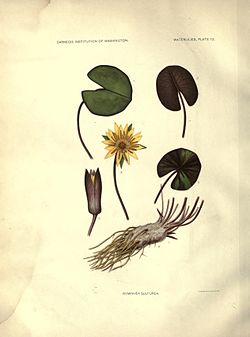Biology:Nymphaea sulphurea
| Nymphaea sulphurea | |
|---|---|

| |
| Botanical illustration of Nymphaea sulphurea in the publication "The waterlilies: a monograph of the genus Nymphaea" by Henry Shoemaker Conard | |
| Scientific classification | |
| Kingdom: | Plantae |
| Clade: | Tracheophytes |
| Clade: | Angiosperms |
| Order: | Nymphaeales |
| Family: | Nymphaeaceae |
| Genus: | Nymphaea |
| Species: | N. sulphurea
|
| Binomial name | |
| Nymphaea sulphurea Gilg[2]
| |
| Synonyms[2] | |
| |
Nymphaea sulphurea is a species of waterlily native to Angola, Zambia, and the Democratic Republic of the Congo.[2]
Description
Vegetative characteristics
Nymphaea sulphurea has stout, cone-shaped rhizomes. The suborbicular to broadly ovate, petiolate,[3] 4.5-5.5 cm long leaves[4] have an entire margin. The petioles are 38–46 cm long.[3]
Generative characteristics
The flowers are 4.5–7 cm wide. The lanceolate sepals with acute apex[3] are 2–3 cm long, and 1.5–1 cm wide. The dark sulphur yellow petals are 2.8–2 cm long, and 1.2-0.7 cm wide.[4] The androecium consists of 40-50 stamens with bright yellow anthers. The gynoecium consists of 12-14 carpels.[3]
Taxonomy
Publication
It was first described by Ernest Friedrich Gilg in 1903.[2]
Type specimen
The type specimen was collected by Hugo Baum in Minnesera on 17 January 1900.[3]
Etymology
The specific epithet sulphurea, from the Latin sulphureus, means yellow,[5][6] and refers to the floral colouration.
Conservation
The IUCN conservation status is Data Deficient (DD).[1]
Ecology
Habitat
Nymphaea sulphurea occurs in rivers, lakes, pools, and in deep waters.[1]
References
- ↑ 1.0 1.1 1.2 Juffe, D. (2010). "'Nymphaea sulphurea'". IUCN Red List of Threatened Species 2010: e.T185239A8373143. doi:10.2305/IUCN.UK.2010-3.RLTS.T185239A8373143.en. https://www.iucnredlist.org/species/185239/8373143. Retrieved 4 January 2024.
- ↑ 2.0 2.1 2.2 2.3 "Nymphaea sulphurea Gilg" (in en). Royal Botanic Gardens, Kew. http://www.plantsoftheworldonline.org/taxon/605720-1. Retrieved 4 January 2024.
- ↑ 3.0 3.1 3.2 3.3 3.4 Conard, H. S. (2015). The Waterlilies: A Monograph of the Genus Nymphaea. Classic Reprint. USA: FB&C Limited. p. 161.
- ↑ 4.0 4.1 Baum, Hugo; Kellen, Pieter van der.; Warburg, Otto (1903) (in de). Kunene-Sambesi-expedition, H. Baum, 1903. Berlin: Verlag des Kolonial-wirtschaftlichen Komitees. pp. 235–236. doi:10.5962/bhl.title.37083. https://www.biodiversitylibrary.org/page/25788021.
- ↑ "The Meaning of Latin Plant Names". http://theseedsite.co.uk/latin.html.
- ↑ Charters, M. L.. California Plant Names: Latin and Greek Meanings and Derivations An Annotated Dictionary of Botanical and Biographical Etymology. http://www.calflora.net/botanicalnames/pageSI-SY.html. Retrieved January 4, 2024.
Wikidata ☰ Q15482226 entry
 |


